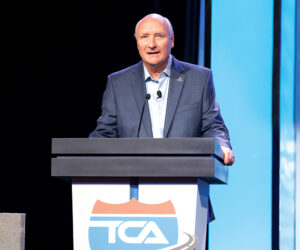WASHINGTON — Freight transportation is vital to the U.S. economy and the daily needs of Americans throughout the country and trucking plays a dominate role in moving that freight. To no one’s surprise, thus says the Federal Highway Administration’s first “Highway Freight Conditions and Performance Report” to Congress, which was mandated by the Fixing America’s Surface Transportation (FAST) Act of 2015.
The report was released July 6. “Households and businesses depend on the efficient and reliable delivery of freight to both urban and rural areas,” the report said. Federal support for freight increased under the FAST Act, which included provisions to define, establish, and provide funding for a national highway freight program.
The FAST Act freight provisions were designed to address significant needs in the transportation system to ensure that projected increases in freight volumes can be handled efficiently across all transportation modes.In 2015, the transportation system handled a record amount of freight — including a daily average of approximately 55 million tons of freight, worth approximately $49.5 billion.
The freight transportation industry employed 4.6 million workers and contributed 9.5 percent of the nation’s economic activity as measured by gross domestic product (GDP). Although freight moves on all modes of transportation, the report said trucks are involved in the movement of most goods.
The report said that 59.9 percent of the total tonnage of freight was moved by truck and 60.7 percent of freight moved in terms of billions of dollars was moved by trucks. The highway system is the most-used mode of transport for freight by tonnage and value of goods moved.
Commodities moved by truck have a higher value per weight, which gives trucking a higher share of freight dollar value. Trucking accounted for nearly 30.5 percent of total transportation and warehousing sector employment. Truck driving is by far the largest freight transportation occupation, with approximately 2.83 million truck drivers. About 57.5 percent of these professional truck drivers operate heavy trucks and 28.2 percent drive light trucks.
The FAST Act also required the FHWA to report on the condition of the National Highway Freight Network (NHFN). In 2012, the NHFN consisted of 51,029 centerline miles, including 46,947 centerline miles of interstate and 4,082 centerline miles of non-interstate roads. Based on 2014 international roughness index (IRI) data from the Highway Performance Monitoring System (HPMS), approximately 77 percent of pavement miles were rated as having good ride quality, 19 percent had fair ride quality, and 4 percent had poor ride quality.
Professional truck drivers might take exception to the agency’s claim that 77 percent of pavement miles are in good condition.The National Bridge Inventory (NBI), which is used to identify current bridge ratings for bridges on the NHFN shows there are approximately 57,600 bridges on the NHFN.
Around 4.3 percent of those bridges were rated as structurally deficient. Most of these structurally deficient bridges are 25 years and older, and over half are more than 50 years old. These findings have implications for future maintenance and funding needs as well as impacts to operations.
The FHWA said travel time, speed and safety are three measures of performance.Slower speeds and unreliable travel times caused by congestion increase fuel cost and affect operations and productivity, which adds expense to the freight transportation system, the report said, noting that in 2014, congestion created stop-and-go conditions on 5,800 miles of the NHFN and caused traffic to travel below posted speed limits on an additional 4,500 miles of the high-volume truck portions of the NHFN.
The projected growth in freight and its reliance on trucks will increase congestion and make it more difficult and costly to move freight.As for the forecast, the report said in 1990, 36.4 percent of the freight moved on the NHFN by trucks. That percentage had jumped to 46.5 percent in 2015 and is forecast to reach 54.4 percent by 2040 for an annual growth rate between 2015 and 2040 of 1.6 percent per year. As for the distance freight travels, the report said approximately 50 percent of large freight trucks (trucks with a gross vehicle weight of over 10,000 pounds) operate within 50 miles of their origination and account for about 30 percent of truck vehicle miles traveled (VMT).
By contrast, only 10 percent of large trucks operate more than 200 miles away from their origin, but these large trucks account for more than 30 percent of overall truck VMT. Long-distance truck travel also accounts for nearly all freight ton-miles and a large share of truck VMT.As for truck parking, the report noted that truck drivers need safe, secure, and accessible truck parking.With the projected growth in truck traffic, demand for truck parking will continue to outpace supply.
In 2014, FHWA worked with States and industry partners on the Jason’s Law Truck Parking Survey Results and Comparative Analysis to assess these needs. The resulting information quantified the commercial motor vehicle parking shortage at facilities along the National Highway System.
The survey provided direct insight into parking issues: more than 75 percent of truck drivers surveyed said they regularly experienced problems finding “safe parking locations when rest was needed.”
Lyndon Finney’s publishing career spans over 55 years beginning with a reporter position with the Southwest Times Record in Fort Smith, Arkansas, in 1965. Since then he’s been a newspaper editor at the Southwest Times Record, served five years as assistant managing editor of the Arkansas Democrat-Gazette in Little Rock and from November 2004 through December 2019 served as editor of The Trucker. Between newspaper jobs he spent 14 years as director of communications at Baptist Health, Arkansas’ largest healthcare system. In addition to his publishing career he served for 46 years as organist at Little Rock’s largest Baptist church.







